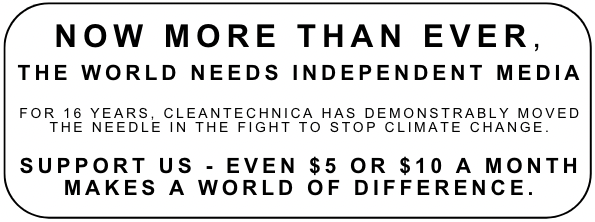
Sign up for daily news updates from CleanTechnica on email. Or follow us on Google News!
Recently, my wife decided that she wanted to watch some old Flintstones cartoons. I mean, who doesn’t like nostalgia? But, being more of a geek, it wasn’t long before I wondered something about one of the voice actors and was Googling things. Before long, I fell down a Flintstones rabbit hole and knew a lot about when the series ran, who voiced different actors, when the crossover cartoon with The Jetsons was made (decades later, who knew?), and many more pointless facts.
While I was learning all of this trivia that might one day come in handy if I were invited onto a game show, I came across one very interesting thing: the use of The Flintstones characters in educational films. It turns out that their popularity and the skills of the cartoonists came in handy for educating kids, adults, and everyone in between about a variety of topics. One of them was energy:
While watching the TV special Energy – A National Issue, which came out the same year as Star Wars, the public had the opportunity to learn about a topic that was still vexxing the country at the time. After all, there had recently been oil embargoes that drove gas prices up and led to long, long lines at stations.
The special was narrated by Charlton “Cold, Dead Hands” Heston, who was famous at the time for playing Moses in a movie and it starred Fred and Wilma Flintstone. This was also the last time that Alan Reed, the original Fred Flintstone actor, played the role before passing away. Heston tells the tale of the development of the Earth, life on it, as well as death and fossilization as it was understood in 1977. This led to the tale of “our fossil fuels, the energy of life”.
Fred’s first appearance in the cartoon comes when he’s out breaking black rocks in the hopes of finding some secret that he can feel in his bones, but gives up to help gather wood and take a break when he “runs out of energy”. The narrator at this point explains that energy decreases as more work is done, using their hunger after work to illustrate it. Energy can come in many forms, but it can sometimes be “stored away” in the form of coal. Fred doesn’t initially understand why someone else (a “traveling stranger”) would want the coal and give him valuable things for it, but then he shows metallurgy relying on a coal fire.
Heston then explains that many good things have come as people have sought something for nothing, even if they can never get it. Moving on to American history, he goes through the use of wood for energy in the early years, followed by coal-powered locomotives and industrial machines later. Whale oil was replaced by petroleum, and by 1977, Americans were using 30% of the world’s energy despite only making up 6% of the population.
Looking at the modern day (with the Flintstones using modern appliances and wearing modern clothes, which was a little weird), the narrator points out that the United States used to use energy from domestic sources, but that growing demand for energy was leading to a lot of imports. They predicted that between 1970 and 1985, the U.S. would use more oil and gas than in all times before.
But, this could happen only if supplies would be available, a point that gets Fred upset, and then he breaks into song as pollution chokes him out. Questions about future technologies (including wind power and electric vehicles), optimism for them, and such are dismissed as only containing “grains of truth”.
The cartoon goes on to explain energy as something that can be measured in units equivalent to barrels of oil. A city of six million people is estimated to use a million barrels’ worth of energy. Obviously, this is just an equivalent, as a variety of fuels were used, even in 1977. Nuclear, coal, methane, and other things provided energy. Heston says, “If steel is the skeleton of the modern world, oil is its blood.” because oil equivalent is easier to understand than kilowatt-hours.
Next (after a weird musical number drilling in barrels of oil per day as the best unit to use), the cartoon explains how much demand for energy had increased from 1950 to 1970, and that demand for energy was only going to rise faster in the coming years. Without conservation measures, the problem would rise to a massive appetite to fill. Even in 1970, 32% of energy came from domestic oil, 33% came from methane, 23% came from coal, 1% came from hydro, and a tiny amount came from nuclear, geothermal, and wood burning. Around 10% was imported.
The big problem was that with growing international demand for energy and limited availability of new fossil fuel sources in the United States, that the cost of energy would only go up instead of going down. Nuclear plants were also estimated to not cover enough of energy needs to make much of a difference.
The cartoon next gets into heat and conversion losses (something people today don’t think about much). Increasing the efficiency of fossil fuel plants, vehicles, and home heating/cooling could greatly improve the situation, but not solve it all. There were limits to what efficiency could save in 1977, so the rest was a zero-sum game where increased energy use comes against environmental and health interests.
In the end, Heston points out that cutting back on energy usage and working harder to develop more fossil fuel sources would be needed to buy time for industry and government to come up with better solutions to the energy dilemma faced in 1977.
Something Better Is Here!
The dismissive attitude toward anything but fossil fuels has given way in recent years to a lot of alternatives. In 1977, there was no rooftop solar or solar farms. There were no viable electric vehicles. There were no heat pumps. Past energy conservation efforts gave us the time needed to get these technologies going and commercially viable, and now it’s time to get serious about moving over to them to let them solve the problem.
But, there are many people who are stuck in the 1977 worldview, where these alternatives aren’t viable or worse, something that could hurt them and theirs.
Featured image: screenshot from the embedded video (fair use).

Chip in a few dollars a month to help support independent cleantech coverage that helps to accelerate the cleantech revolution!
Have a tip for CleanTechnica? Want to advertise? Want to suggest a guest for our CleanTech Talk podcast? Contact us here.
Sign up for our daily newsletter for 15 new cleantech stories a day. Or sign up for our weekly one if daily is too frequent.
CleanTechnica uses affiliate links. See our policy here.
CleanTechnica’s Comment Policy




